Blog Archives
‘An Enemy of the People’ Brilliant, Drop Dead Tragicomedy With Jeremy Strong, Michael Imperioli
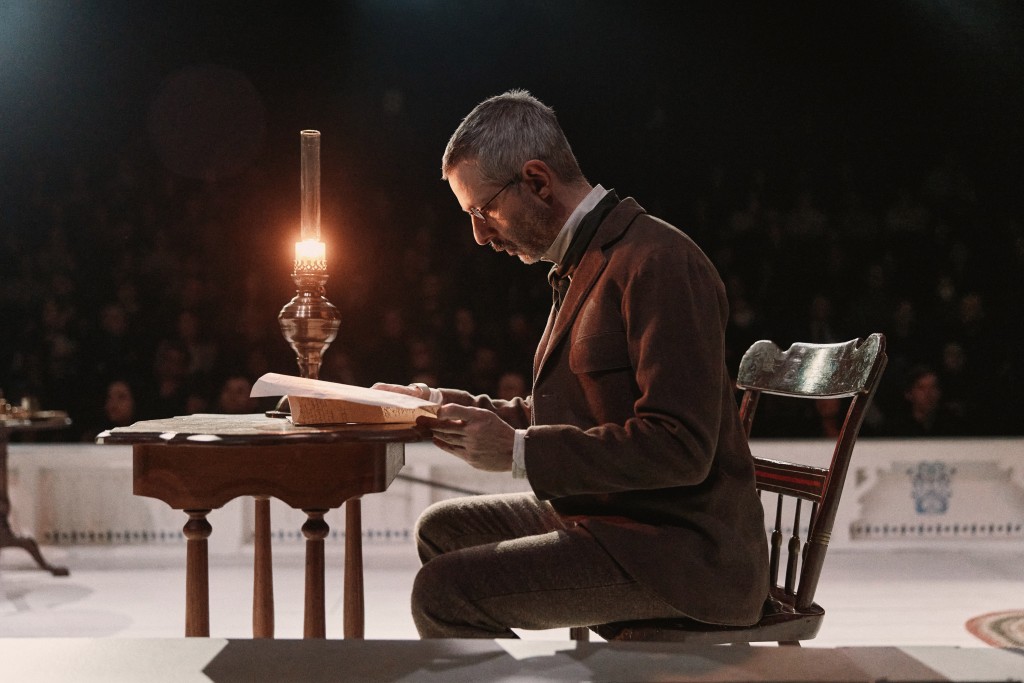
In Amy Herzog’s adaptation of Ibsen’s sardonic An Enemy of the People, currently at Circle in the Square for a limited engagement, we are treated to a modernized version of a work whose timeless verities ring true for us today. Aptly directed by Sam Gold (A Doll’s House Part 2), Jeremy Strong (TV: “Succession”) as Dr. Thomas Stockmann and, Michael Imperioli (TV: “White Lotus”) as his brother, Peter Stockmann, go head to head about a subject that should concern every politician and citizen on the planet: clean, potable water.
In adequately slimming down Ibsen’s five act play to highlight important themes that are taken out of our current headlines, Amy Herzog confirms her penchant for adaptation. Successful with the process of refining, to trim the salient dialogue and concepts of a classic work, Herzog’s minimalist adaptation of A Doll’s House was nominated for a Tony Award. Likewise for An Enemy of the People, Herzog tames the unwieldy Ibsen sentence construction and vocabulary (sometimes hampered by translation from the Norwegian), so its clarification provides accessible, trenchant, stark meaning with a greater impact than the work may have had in an original translation.
Other changes in characterization compact the play’s crystalline focus. Conjoining two characters (Petra and Mrs. Stockmann) into just daughter Petra (Victoria Pedretti), Herzog humanizes Dr. Stockmann, who misses his dead wife, and is gratified that his remaining family is close and supports him. Reinforcing Petra’s identification with her father, Herzog intensifies Stockmann’s dilemma and persecution which becomes Petra’s problem as well. So we appreciate her defense of her father and courage in braving the victimization and town’s retribution after the doctor attempts to save the town from itself by blowing the whistle about a nearby spa’s contaminated water supply.

Herzog emphasizes the situation and brings it rapidly to a crescendo. It begins with acknowledgement of Stockmann’s heroism by his friends. The fine scientist and researcher sends the nearby resort’s water sample to the university lab which affirms disease-causing, killing bacteria in the water. In Europe those who would visit spas for treatment, sometimes would “take the waters,” meaning drink the waters for their reputed, curative healing effects. Stockmann has discovered that if the patrons sip the “healing” waters, the tourists will become deathly ill. If they bathe in it, perhaps the polluted water won’t be as immediately disastrous, but it will be dangerous. This is Ibsen at his sardonic best and the message is meaningful for us today, (water damaged by PCBs, microplastics, hormone disruptive contaminants). Though Ibsen wrote the play over 140 years ago, little seems to have changed.
When Stockmann’s more liberal friends, newspaper editor Hovstad (Caleb Eberhardt), his assistant, Billing (Matthew August Jeffers), and even Aslaksen, Chair of the Property Owner’s Association and printer (Thomas Jay Ryan), hear of Stockmann’s prescient action, they deem him to be heroic in “saving” the town. During their discussion we find out that both Hovstad and Billing resent the wealthier investors having come from impoverished backgrounds; they encourage the doctor to publish the report. Additionally, Aslaksen, wants to hold a dinner party and present Stockmann with a small award. Aslaksen, a self-declared “man of moderation” says, “nothing too flashy, we don’t want to ruffle any feathers.
To complicate the situation, Stockmann’s father-in-law, Morten Kiil (David Patrick Kelly), who is still alive and a wealthy man, owned one of a number of tanneries near the spa area. Apparently, Kiil and the other tannery owners “forgot” to properly dispose of the chemical runoff used to cure the hides and the poisons have seeped into the water table. (Think of Jonathan Harr’s book and adapted film A Civil Action, about the pollution of the Woburn, Massachusetts water supply that sickened and killed children and families.).
Petra reminds her father that he suggested before the construction of the resort that they make adjustments for such a possibility because Stockmann feared the tannery’s proximity. However, his brother, Peter (the town mayor), the investors and officials shot down the doctor’s idea because of additional cost and delay. Their wants were understandable; the sooner they opened the resort and spa to make money and bring tourists in droves to the town, the better. Indeed, the town, in anticipation of the spa’s opening in the summer has grown more prosperous and the people are looking forward to servicing the tourist trade that the spa will bring.
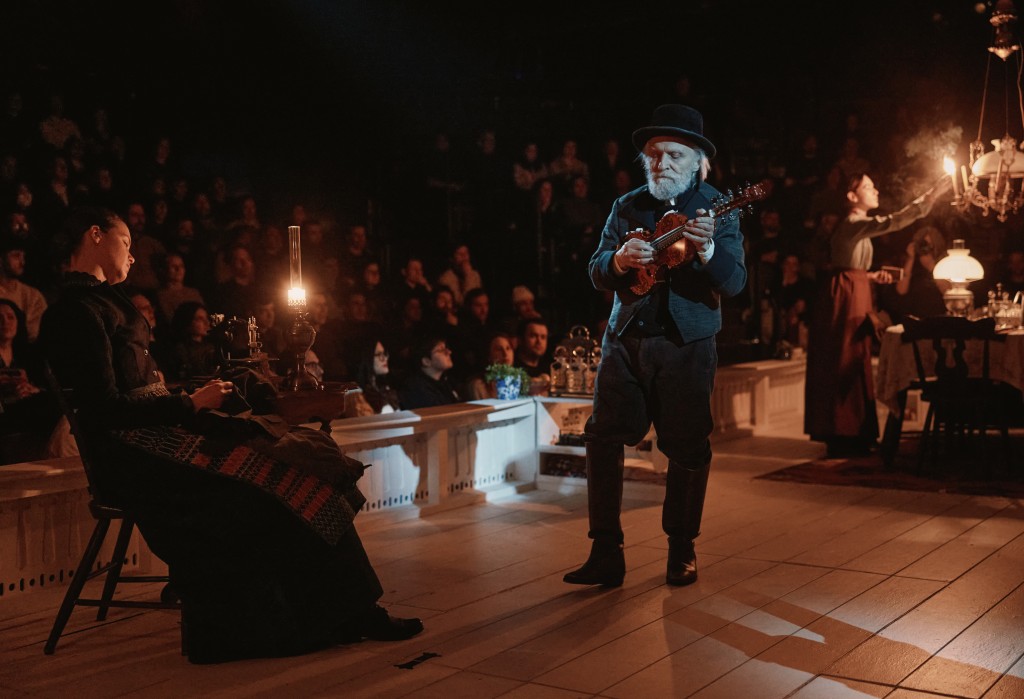
Clearly, money “trumps” the viability and security of the spa. Stockmann’s science and the safety and sanctity of human life are in bondage to financials and commercialism. The developments that follow after Stockmann receives the lab report hang in the balance. Will his boss and brother, the mayor and investors agree that the situation warrants rehabilitation of the baths, though that might jeopardize the town’s commercial viability? Or will the mayor and investors hold the line that the spa and resort be opened and celebrated, despite the potential harm to come? In other words should the truth be exposed or covered up?
The brothers are on opposite sides of the dilemma; one represents science, the other the town’s economic prosperity. A critical factor is that Peter is Thomas’ boss and Thomas answers to him. As Dr. Stockmann lives for his work, so does his brother Peter, who has never married and demonstrates overweening pride as the mayor servicing the richest, most prosperous citizens. If they were at odds with each other before, with Peter ignoring his brother’s scientific suggestions and criticism of his “liberal” newspaper friends, their conflict explodes after the doctor confronts Peter with the report.
Unfortunately, the doctor’s idealism and self-righteousness has blinded him, as Peter’s greed, self-importance and his rich friends sway him beyond human decency. Peter appears to hold all the chips in this poker game. Their struggle is an iconic one and Gold’s direction and Strong and Imperioli’s acting are on-point superb during their interactions and arguments and especially at the town meeting.
Of the doctor’s three friends, Aslaksen is the one who anticipates that various townsfolk may not perceive Stockmann as a hero. And indeed, when the mayor reads Stockmann’s report, he takes it personally as an attack based on resentments stemming from their childhood. Beholden to wealthy interests, Peter actively dismisses the gravitas of what Thomas suggests and refers to his brother’s pronouncements as “speculation and wishful thinking,” and he insists the doctor’s attitude is “spiteful and childish” for cutting off the town’s “only” source of income.
From his perspective the proof screams at Thomas about how dire the situation is. Thus, the doctor expects his brother to retrofit the baths and delay the opening of the spa, though he has not researched the practicality of how long it will take and how much it will cost. The situation can be mitigated if the two sides agree to tackle the problem rationally and intelligently. However, both brothers cast it as an either or situation and Peter is predisposed to cover up the noxious, infernal truth and proceed with the spa’s poisoned-filled opening.
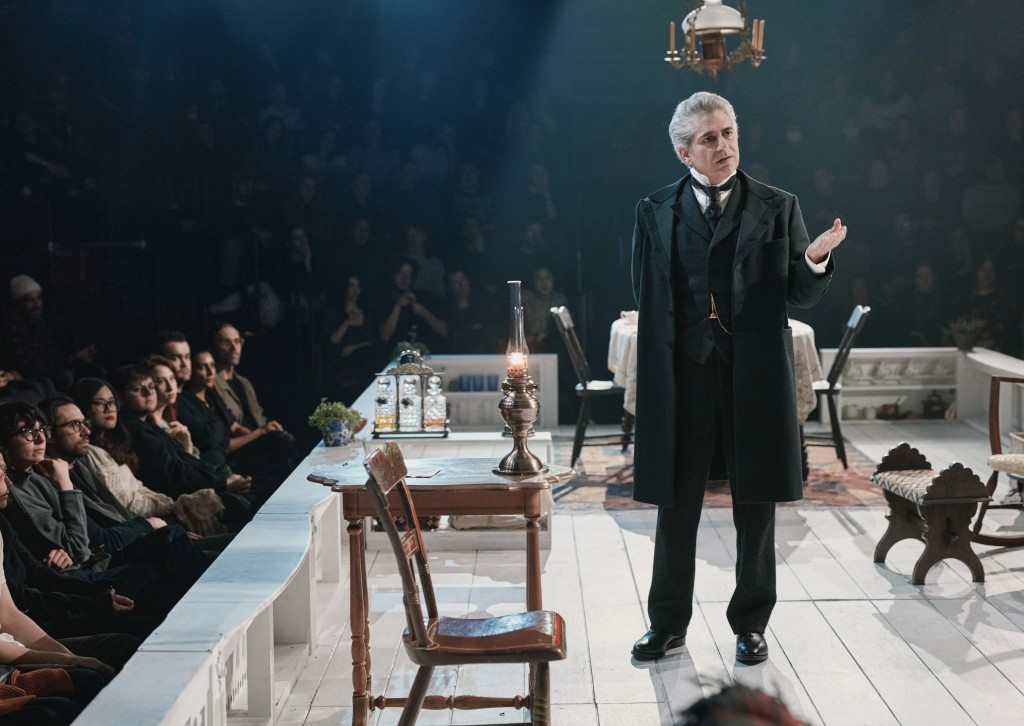
The genius of An Enemy of the People is the way in which the situation and character interactions reveal social and personal dilemmas. Do we uplift human rights supporting the sanctity of life and security for all as the doctor does? Or are rights subject to economic and class background and curtailed accordingly, as Peter wishes? Are we generous and life-supporting or selfish and nihilistic? Are those with money truly superior or is their arrogant, self-importance riddled with flaws because to value money and power over human life is suicidal folly that leads to catastrophic, karmic consequences?
In this play, Ibsen reveals the perniciousness of toadying to class and money at the expense of life and health. And so it goes with Peter, the mayor, who bows to special interests despite the apocalyptic moral imperative that the spa will kill instead of heal. According to the mayor, the cost and delay will bankrupt the town. He manipulates and threatens Thomas’ friends Hovstad, Billing and Aslaksen so that they turn against Thomas to “save” the town from the financial debacle that will occur if the spa closes.
As forces converge against Thomas, and his friends who once stood by him back away from his facts, we note that financial viability is the only consideration, when it doesn’t have to be. The arguments given settle in the “benefit” to the town’s prosperity which will be destroyed if they take two years to retrofit the spa. The spa supporters affirm that surrounding towns will jump in the gap and create their own resorts and wipe them out competitively by the time they finish their corrections. If they cover up the truth, at least the town will prosper commercially and the investors will receive an immediate return on the investments.
In their arguments, not one of the spa supporters, Stockmann’s friends or the mayor consider that tourist deaths and subsequent lawsuits could force the town into bankruptcy. Even worse, the scandal of a cover-up and eventual publicized expose will necessitate investigations and the public humiliation and outcry that such was allowed by the mayor, etc., destroy the town’s reputation and revenue for a long time to come. The gaslighting notion that the doctor’s facts are “speculation” is actually the fantasy (“wishful thinking”) that the bacteria and poisons in the water are not harmful and/or don’t exist. The investors, town and mayor are “damned if they do, and damned if they don’t.”
Rather than correct their attitude and behavior, Peter and his supporters double down on their initial dereliction in not following the doctor’s suggestions. They turn on him blaming him for the situation which they negligently in a criminal dereliction of duty refuse to believe and act on.
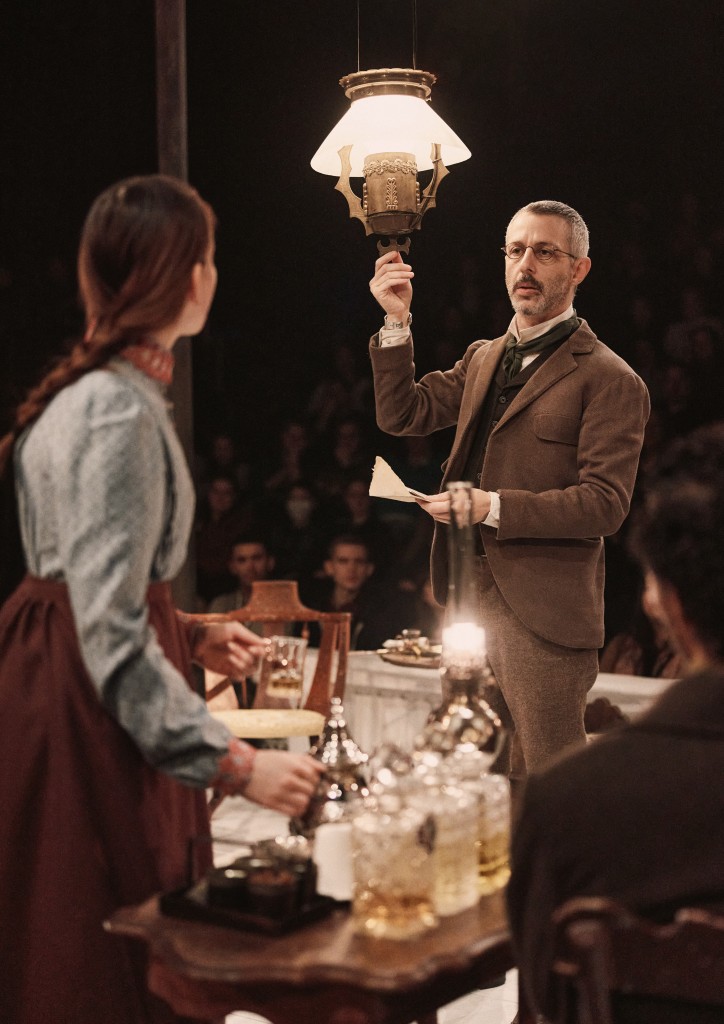
Strong’s doctor gives an impassioned speech to Peter, Hovstad, Aslaksen and Billing. He prophesies that he will present the truth at a general meeting and save lives regardless of their position not to publish the report. The town should be able to hear and decide the best path to take. At the end of his arguments with Aslaksen, his brother and the others he states, “I have faith in the people of this town. You can fire me, you can shun me. But you can’t stop me from telling the people the truth.” Strong’s performance is authentic; we believe him and hope with him. It is a superbly unforgettable dramatic moment.
It is also an excellent place to create “the pause” (not an intermission), which lasts five minutes, then segues into the town meeting where Stockmann presents the report. The playing area is converted from Dr. Stockmann’s atmospherically lit house and study, into a well-lighted bar where drinks (aquavitae) are served to the audience. Gold has dynamically staged this segment so that audience and actors mingle and imbibe for the five-minute interval. The atmospheric lighting of the first half of the production with gorgeous antique lamps from that period is replaced during this “pause”. The theater’s regular lighting is turned on as the drinks are served. It stays on, then, as the town meeting gets underway, and the play resumes with lights down, Dr. Stockmann confronts the mayor, his former friends and the townspeople.
This is genius staging because during the “pause,” Gold moves us from the past to the present in a time meld, and we are reminded of the currency of this play’s situation and themes.
Then the town meeting ensues. It is terrifying and fascinating. The mayor, Hovstad and others shut the doctor down with loud verbal muscling. When Thomas stands up to them speaking the truth, whipped up by the mayor and others, the townspeople repeat the others’ refrain that Thomas is “an enemy of the people,” and physically beat him. Strong’s performance and the ensemble’s counter-performances are incredible.
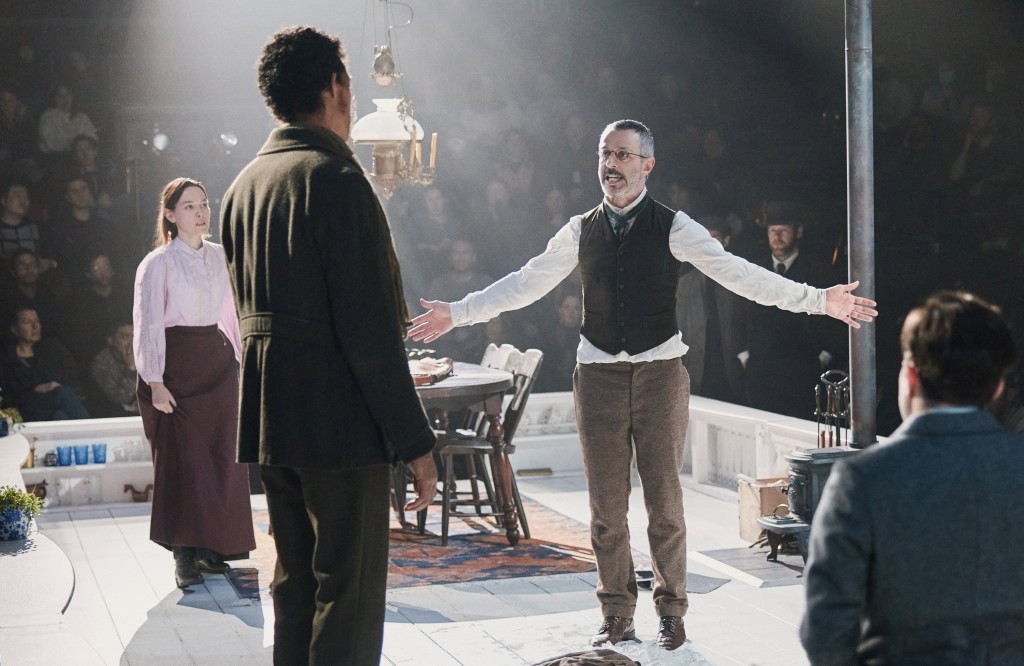
As we stand in the doctor’s shoes, we identify with his untenable situation which is beyond irony. This is especially so after he is pummeled with buckets of ice (the symbolic equivalent of a stoning) thrown on top of his head. Strong’s Stockmann rips off his shirt and offers his life for them if only they would accept the truth. The irony is complete. The townspeople and his brother want their fantasy. His life and their own lives are worth nothing. Money is everything. They believe that the spa will bring prosperity and money though they may not live to see it. They can’t handle Thomas’ “facts.”
We have seen this picture played out before in the COVID political botch job of the former president, who, like Peter the mayor, eradicated the deadliness of the virus with his lies and misdirection, as the US charts the largest number of COVID deaths globally to date; yes, people are still getting COVID and dying from it. The townspeople’s rejection of Stockmann’s facts hyped up by the mayor and his cohorts parallel MAGA’S convenient rejection of the truth for “alternate” facts (conspiracy theories) which they rabidly cling to in a morbidly cultish intractability whipped up by MAGA politicians. Then as now, science is rejected by those who wear their lack of education and ignorance on their sleeves, as the facts become others’ “wishful thinking.”
What is particularly ironic about seeing this production is the extended parallel of censorship then and now but differently processed. Ibsen never imagined media, social media and AI. Instead, of publishing Thomas’ factual report, the town paper is silent about the danger, censoring the report. Today, lies are broadcast on various media platforms including “Truth Social” precisely to extinguish the credibility of facts. The loudness and cacophony of wrong information and falsehoods deafen those willingly, lazily duped into a conspiracy of complacent trust. Those who would not be duped must read extensively to separate truth from lies and silence the cacophony to tease out what is really happening.
Do we laugh or cry? My response to Strong’s impassioned speeches after his beating and vilification was panic laughter and a few tears at the enormity of witnessing the play’s themes which resonated for me as an anti-MAGA who watched Republican truth-tellers like Liz Cheney, the former president’s Republican administration witnesses at the January 6th Commission, Dr. Fauci, former Governor Andrew Cuomo, and a legion of others who stood and still stand for the truth against the fraudulent former president. For their pleas of truth, they, like Strong’s Stockmann, have been symbolically crucified, character assassinated, demeaned, defamed and threatened with death. The dark ironies of this production are drop dead tragicomedy that is nonpareil in today’s theater.
And as such, this production is a warning. The message for me was “not on my watch!”

There are those who deny and punish truth tellers, whether scientists or Cassandras. Indeed, the more the leaders and their followers cry for blood, it would seem that the greater the confirmation that what is being said that inflames them is accurate. The final twist in this magnificent work which Herzog, Gold and the phenomenal actors have made as plain as day, you will have to see for yourself, if you can get a ticket. The conclusion just might involve a rescue by Captain Horster (Alan Trong), keen on Petra, who offers to take Stockmann, Petra and Stockmann’s son to America. Why? It is better there and the citizens are more amenable to hearing the truth. The audience laughter was as bitter as the dark irony inherent in Captain Horster’s innocent comment.
Re-imagining An Enemy of the People, Herzog, Gold and the creative team have delivered a searing, terrifying and at times humorous work that will remain in one’s consciousness long after one leaves the Circle in the Square. From the imaginatively stylized, technically galvanizing and evocative set design by dots, to the superbly thematic lighting design by Isabella Byrd, the period costume design by David Zinn, and Campbell Young Associates hair and wig design, the director’s vision coheres powerfully.
The singing of Norwegian folk ballads throughout is an additional atmospheric element that establishes setting and grounds us in history. Norway is a place that is often presented as more forward thinking than the US, another irony. Human nature is similar everywhere, especially when ignorance can be manipulated for profit and the illusion of prosperity for the poor, which rarely happens. Mikaal Sulaiman’s sound design helps to convey the timber of the music and voices. It might have been interesting to see a translation of their lyrics in the program.
An Enemy of the People is in a 16 week limited engagement that ends June 16. It is two hours with a five minute pause and no intermission. Circle in the Square, 235 West 50th St. between 7th and 8th. See it for its performances, the fine direction and inspired re-imagining. https://anenemyofthepeopleplay.com/
‘A Doll’s House,’ Jessica Chastain’s Nora is Brilliantly Unbound

As a masterpiece of modern theater Henrik Ibsen’s A Doll’s House presciently foreshadowed the diminution of a women’s role as homemaker. Ibsen shattered the notion of a woman being a husband’s pet, an obedient robot/doll with no autonomy or identity of her own, who cheerfully accepts the delimitation of traditional folkways. A maverick play at the time, A Doll’s House was considered controversial. Ibsen was forced to rewrite the ending for German audiences so it was acceptable.
What would those audiences have said about Amy Herzog and Jamie Lloyd’s stark, minimalist, conceptually powerful, metaphoric version currently at the Hudson Theatre? It is a version which relies on no distracting accoutrements of theatrical spectacle, i.e. period costumes and plush drapery. Nothing physically tangible assists with the unlacing of “the bodice” of Nora’s interior. With “little more” than cerebral irony, and emotional grist, Nora displays her soul in a genius enactment by the inimitable Jessica Chastain, in the production of A Doll’s House, which runs a spare one hour and forty-five minutes with no intermission.
The plot development, characters and themes are Ibsen’s. Nora, a pampered, babied housewife, to save her husband’s life, unwittingly commits fraud by borrowing money from loan shark Krogstad (Okieriete Onaodowan who in the first scene needed to project his voice so as not to appear a weak character which Krogstad is not). Complications arise when Torvald (an exceptional Arian Moayed), receives a bank promotion. With the additional money, Nora plans to quickly pay back Krogstad. But the loan shark threatens to expose Nora’s secret, unless she can save his job at the bank, where her husband has just become his boss.
Tensions increase when Torvald fires Krogstad and hires Nora’s friend Kristine (Jesmille Darbouze). Nora must confront the situation with Torvald before Krogstad exposes her and destroys Torvald’s reputation and their marriage.

Lloyd and Herzog are a fine meld. Herzog strips extraneous words and phrases, though not the substance of the pared-down dialogue. Her version is striking with a natural, informal, un-stilted speech for concentrated listening. There’s even a “fuck you” which Nora proclaims cheerfully to be bold, though not in Torvald’s hearing. The meat is Ibsen; the forks and knives to devour it are sleek and without ornamentation to distract. The themes and characterizations are bone chillingly articulate, which Herzog and Lloyd excavate with every word and phrase in this acute, breathtaking, ethereal, new version of A Doll’s House.
Lloyd eliminates the comforting, elaborate staging where actors might have moved to and fro amongst luxurious furniture and eye-catching, gloriously-hued dramatic sets that show Torvald’s preferred, lifestyle, which Nora scrimps from her own “allowance” to maintain. Instead, the ensemble’s movements are restrained. They step quietly around Soutra Gilmour’s set. Gilmour has distilled Lloyd’s vision to the back stage wall, top-half painted black, with attendant muted white painted on the bottom half of the wall. The flooring is grey. Predominant are the revolving platform and institutional-looking bland chairs which actors bring in and place on the sometime circling platform, or on its outer edges which don’t revolve.
Chastain appears twenty minutes before the production begins, seated in a chair revolving on the platform (I should have counted the repetitions, but I didn’t.). Sitting, she fascinates. Initially, to me, she was invisible; I was distracted, while she quietly walked on bringing her chair. She was a part of the onstage background, muted, unremarkable. That is perhaps one of the many concepts Lloyd and Herzog suggest with this enlightened version that is memorable because it is metaphysical and conceptual, giving rise to themes about soul interiors and women’s invisibility in the patriarchal culture.
One theme this set design suggests is that we travel in our own orbits, going in circles in our own perspectives, unseen and never truly known as psychically present, spiritual beings. And as Ibsen suggests, it takes an inner cataclysm such as Nora experiences to break from traditional mores and behavioral repetitions into a different consciousness and new way of being. This breakthrough, Nora attempts at the conclusion.

Amy Herzog’s modernized language version of A Doll’s House is one for the ages in focusing Ibsen’s power of developing characterizations. It presents an opportunity for Lloyd’s preferred, stylized, avant-garde staging, similar to what he used in Betrayal (2019) and Cyrano (2022). It requires the audience to listen acutely to every word of the dialogue and scrutinize the actors splendid, nuanced emotions which flicker across their faces. This is especially so of Chastain’s Nora, who is chained and bound symbolically throughout, minimally using gestures or any physicality, as she sits in a chair facing the audience. Predominately. she employs her voice and face to convey the interior-organ manifestation of Nora’s tortured, miserable psyche. For example when the wedding ring is returned, Nora and Torvald do not move; there is no ring. They look at one another, however, the unspoken meaning resonates loudly.
Even the tarantella Nora dances at the costume party, Chastain wrenches from herself sitting in the chair in a frantic nearly psychotic frenzy of shaking and kicking. The earthquake physicality that splits Chastain’s Nora apart is the only broad, physical movement, other than walking out of her stifling, meaningless existence, that Chastain and Lloyd effect with novel irony at the conclusion. The chair-dance is an explosive, rage-filled fit of exasperation, principally done for the purpose of distracting Torvald. Desperate to prevent his discovery of corrupt loan shark Krogstad’s blackmail plot, Nora’s diversion succeeds for a time. However, her fear and inner bleeding wounds only augment, until her behavior is exposed and Torvald unleashes his fury, vowing she must not infect the children with her poisonous corruption. Interestingly, the children ethereally “appear” as voices in voice- over recordings. Nora speaks to them, looking out in the direction of the audience. Hypocritically, Torvald demands she stay away from the children, though she must remain with the family to keep up appearances as his jeweled asset and prize doll.
With Lloyd’s symbolic staging, Chastain’s Nora proves that body, soul and mind are inseparably engulfed in the trauma of a paternalistic culture, represented by males who “love her the most” (her father and husband), and psychically straight-jacket and gaslight her to adopt their thoughts, behaviors and attitudes as right and true. To do this she nullifies her existence as a “human being.” In this production, Herzog, Lloyd, Chastain and the ensemble display this truth. It is undeniably representative of women in 1879, the projected number on the back wall of the stage that appears in the beginning of the production.

And when the number disappears, we understand that Soutra Gilmour’s black, white, grey set design, and Gilmour and Enver Chakartash’s costume design (modern dress black), function to speed us through 140 + representative years to display the dominant patriarchal attitudes today. These folkways still straight-jacket, demean and traumatize. If one thinks this is fatuous “woke” hyperbole that is finished, one has only to read the one in four statistics of women who are bound in violent relationships with male partners who beat or abuse them, yet cannot leave for fear of being alone or without the means to support themselves or their children. The LGBTQ community is not excepted from this. Humanity has a penchant for violence. If it is not externalized, the violence is psychic and emotional, where not a hand is raised toward a partner, yet the words and silences traumatize. It is the latter psychic trauma that Ibsen/Lloyd explore.
Whether in Ibsen’s historically, visually laden production of A Doll’s House, or in Lloyd’s naked, bleak and blasted version, it is a despotic spirit that demands obeisance, excluding other ways of being to exalt itself by oppressing and choking the life force from “the other,” whether gender-conforming or LGBTQ. That Chastain has the chops to convince us that we are witnessing every stressed fiber of her nerve endings annihilated, as she inhabits one of the most well-crafted characters in drama, is astounding and not to be underestimated, as some have done, implying her Nora “cries too much.”
Suffice to say, those are not female critics, of which there are far too few. However, her performance is emotionally handicapped accessible for those without a hearing ear, who may need to see Jamie Lloyd’s phenomenally sensitive direction a few times to “get it.” And happily many men do get it. They stood, cheered and whooped during the curtain calls when I looked around to see who was standing at Wednesday’s March 14th matinee. More importantly, women also cheered and whooped.
Clearly, husbands/partners, who might be like Torvald, need to see this production, if they suspect they are like him. Chastain’s Nora is an educational experience in how a particular woman suffers to the breaking point in order to be the prototype ideal wife and mother for a man’s “love” and acceptance. When Nora finally realizes she has the tools to free herself from the false and illusory prison of her own making, she throws off a life and role she believed made her happy to search for definitions of her own happiness.
Moayed’s Torvald, who portrays the solipsistic, presumptuous, self-aggrandizing, martinet with likable charm (how he does this is incredible), exposes her to herself. He smashes her fantasies that he is a white knight, who will do the “beautiful thing,” by sacrificing himself for her, as she has done for him.

Unfortunately, the only one who would sacrifice himself for her is on his way out of life. Chastain’s scenes with Michael Patrick Thornton’s Dr. Rank, who is the couple’s terminally ill close friend, are touching, warm and human, unlike her scenes with Torvald. They should be together, but she won’t push their light flirtations beyond, loyal to her fantasy of Torvald, until she isn’t.
Interactions between Nora and Torvald are increasingly transparent as they devolve into Torvald’s eventual explosion and hatred directed at Nora after discovering the truth. The scenes between Krogstad and Kristine pointedly contrast and move in the opposite direction. Kristine’s persuasive love of Onaodowan’s Krogstad makes him swallow his “pride” and give up his extortion plan. Truth is at the core of their love. Onaodowan and Darbouze are particularly strong and authentic in their scene together which reveals Kristine and Krogstad’s love has remained over the years. On the other hand Torvald and Nora’s toxic relationship functions in falsehoods. Lies are at its core, and what is presumed to be love is convenience and objectification. Torvald demands Nora be his dream doll and she obeys, though it demoralizes her soul.

Kristine’s troubled life has brought her to an understanding of herself in an honesty which Krogstad appreciates, for he wants to give up his corrupt way of life. That Lloyd has selected two Black actors to portray these characters reveals an underlying authenticity and exaltation for their love. Krogstad, who is in the shadows when we first meet him, as he sits behind Nora and blackmails her (unfortunately I had to read the script to understand these lines), appears the villain. He is made more villainous by the society’s ill treatment of him, but his love for Kristine redeems him. Torvald’s inability to love Nora damns them both.
Ironically, when her friend’s love is rekindled, Nora’s love ends, as she realizes Torvald’s true nature and relationship to her. Though he apologizes for “going off” in a diatribe superbly delivered by Moayed, Torvald’s narcissism which can’t abide anything hurting the Torvald “brand,” is egregious. His presumption is a delusion, for she saved his life; he wouldn’t exist but for her.
Herzog’s spare dialogue reveals how loathsome Torvald is in the last scene, when Nora tells him she believed him to be her white knight who would take the blame for her mistake. She insists she would have killed herself to stop his sacrifice for her. It is laughable when he says he would do anything for her, but he “won’t do that.” With conviction speaking for the entire tribe, Moayed states, “No man sacrifices his dignity for the person he loves.” Nora counters, “Hundreds of thousands of women have done that.” When Torvald begs her to stay for the children, he is the weak, despicable coward. His concern is pretentious show to make her feel guilty for leaving. Nora can’t be pressured. She knows Torvald will dump the inconsequential children’s care on their Nanny Anne-Marie (Tasha Lawrence).
Nora allows Torvald’s toxic masculinity to forge the chains which she uses to bind herself in the confines of a paternalistic culture that promotes attitudes about “the little wife.” Meanwhile, his little “bird” lacks a being and ethos apart from him. The only freedom, identity and empowerment Chastain’s Nora will ever receive is one she fashions for herself. This, she ironically and joyously enforces at the play’s conclusion.
How are such incredible performances by Chastain, Moayed and the others so beautifully shepherded? Lloyd economizes to the essence of thought in the lines reworked by Herzog. The evocative minimalism heightens the play’s timelessness and draws into crystal clarity the subtle, “loving” oppressive fantasies men and women (or whatever gender relationships), rely on to sustain power dynamics in their coupling. Without underlying truth and honesty to bolster the relationship and weather horrific storms, the illusions become insupportable and the personalities and relationships shatter.
Kudos to all in the creative team I may not have noted previously, including Jon Clark (lighting design), Ben & Max Ringham (sound design), the ominous, haunting music by Ryuichi Sakamoto & Alva Noto, and dance choreography by Jennifer Rias. For tickets to this maverick production, go to their website https://adollshousebroadway.com/